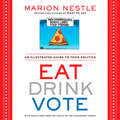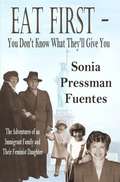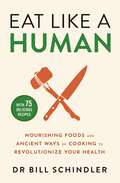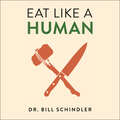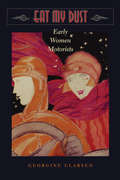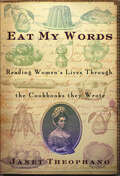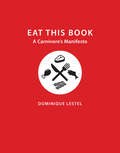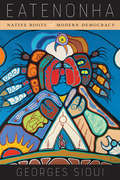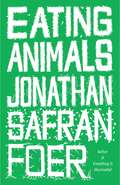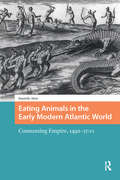- Table View
- List View
Eat Drink Vote: An Illustrated Guide to Food Politics
by Marion NestleWhat's wrong with the US food system? Why is half the world starving while the other half battles obesity? Who decides our food issues, and why can't we do better with labeling, safety, or school food? These are complex questions that are hard to answer in an engaging way for a broad audience. But everybody eats, and food politics affects us all.Marion Nestle, whom Michael Pollan ranked as the #2 most powerful foodie in America (after Michelle Obama) in Forbes, has always used cartoons in her public presentations to communicate how politics—shaped by government, corporate marketing, economics, and geography—influences food choice. Cartoons do more than entertain; the best get right to the core of complicated concepts and powerfully convey what might otherwise take pages to explain.In Eat Drink Vote, Nestle teams up with The Cartoonist Group syndicate to present more than 250 of her favorite cartoons on issues ranging from dietary advice to genetic engineering to childhood obesity. Using the cartoons as illustration and commentary, she engagingly summarizes some of today's most pressing issues in food politics. While encouraging readers to vote with their forks for healthier diets, this book insists that it's also necessary to vote with votes to make it easier for everyone to make healthier dietary choices.
Eat First -- You Don't Know What They'll Give You
by Sonia Pressman FuentesSonia Pressman Fuentes, who was born in Berlin, Germany, came to the US as a child with her immediate family to escape the Holocaust. Her memoirs reveal how this five-year-old immigrant in 1934 grew up to become the first woman attorney in the Office of the General Counsel at the Equal Employment Opportunity Commission (EEOC) in 1965, one of the founders of the National Organization for Women (NOW) in 1966, the highest-paid woman at the headquarters of two multinational corporations--GTE and TRW, and an international speaker on women's rights for the US Information Agency. The author of this book donated a digital copy to Bookshare.org. Join us in thanking Sonia Pressman Fuentes for providing her accessible digital book to this community.
Eat It Anyway: Fight the Food Fads, Beat Anxiety and Eat in Peace
by Eve Simmons Dennison'One cannot think well, love well, sleep well, if one has not dined well.' - Virginia Woolf.The definition of 'healthy eating' has been chewed up, spat out and re-digested enough times to make Joe Public give up and seek out their nearest branch of McDonald's. Our mindless obsession with eating 'right' is such that we're now more concerned about what our Instagram followers think of a poorly lit picture of our dinner than we are of its effect on our own palate. Or, indeed, our happiness. We seem to be living in a time where we no longer eat with our hearts, emotions or heritage - but with what our waistlines (and followers) in mind.Not Plant Based are on a mission to help you love food again. The principle is very simple: eat what you like and don't worry about it. It's a menu that's especially delicious, 'guilt-free' and requires a hell of a lot less money spent in health food shops. Throughout the book, Laura and Eve call on experts to debunk myths and provide a balanced exploration of our attitude towards food, with some delicious recipes thrown in along the way. They discuss their own experiences of eating disorders and offer personal tips and coping mechanisms to help rid you of anxiety linked to food. No one is saying healthy eating is bad; there is simply a lot of misleading information out there. More to the point, food is so much more in the grand scheme of life than health: it's family, friends, enjoyment and memories. So go on, take a bite out of Eat It Anyway and learn to love your food all over again. It's SO mouth-wateringly good - we bet you'll be back for seconds.**PRAISE FOR EAT IT ANYWAY**'Learn to love food again with this book, which sorts nutritional nonsense from sensible science' - Woman's Weekly
Eat It Anyway: Fight the Food Fads, Beat Anxiety and Eat in Peace
by Eve Simmons Dennison'One cannot think well, love well, sleep well, if one has not dined well.' - Virginia Woolf.The definition of 'healthy eating' has been chewed up, spat out and re-digested enough times to make Joe Public give up and seek out their nearest branch of McDonald's. Our mindless obsession with eating 'right' is such that we're now more concerned about what our Instagram followers think of a poorly lit picture of our dinner than we are of its effect on our own palate. Or, indeed, our happiness. We seem to be living in a time where we no longer eat with our hearts, emotions or heritage - but with what our waistlines (and followers) in mind.Not Plant Based are on a mission to help you love food again. The principle is very simple: eat what you like and don't worry about it. It's a menu that's especially delicious, 'guilt-free' and requires a hell of a lot less money spent in health food shops. Throughout the book, Laura and Eve call on experts to debunk myths and provide a balanced exploration of our attitude towards food, with some delicious recipes thrown in along the way. They discuss their own experiences of eating disorders and offer personal tips and coping mechanisms to help rid you of anxiety linked to food. No one is saying healthy eating is bad; there is simply a lot of misleading information out there. More to the point, food is so much more in the grand scheme of life than health: it's family, friends, enjoyment and memories. So go on, take a bite out of Eat It Anyway and learn to love your food all over again. It's SO mouth-wateringly good - we bet you'll be back for seconds.(p) 2019 Octopus Publishing Group
Eat Like a Human: Nourishing Foods and Ancient Ways of Cooking to Revolutionise Your Health
by Bill SchindlerVegan or carnivore? Vegetarian or gluten-free? Keto or Mediterranean? Fasting or Paleo? Our relationship to food is filled with confusion and insecurity. Every day we hear about a new ingredient that is good or bad, a new diet that promises everything. But the truth is that none of those labels matter. The secret to becoming healthier, losing weight, living a pain-free and energetic life and healing the planet has nothing to do with counting calories, reducing portion sizes or feeling deprived - the key is re-learning how to eat like a human.This means finding food that is as nutrient-dense as possible, and preparing that food using methods that release those nutrients and make them safe and bioavailable to our bodies, which is exactly what allowed our ancestors, millions of years ago, to not only live but thrive. Archaeologist and primitive technologist Dr Bill Schindler draws on cutting-edge science and a lifetime of research to show readers how to live like modern 'hunter-gatherers' by using the same strategies our ancestors used - as well as techniques still practiced by many cultures around the world - to make food as safe, nutritious, bioavailable and delicious as possible.With each chapter dedicated to a specific food group, in-depth explanations of different foods and cooking techniques and concrete takeaways, as well as 75+ recipes, Eat Like a Human will permanently change the way you think about food, and help you live a happier, healthier, and more connected life.
Eat Like a Human: Nourishing Foods and Ancient Ways of Cooking to Revolutionise Your Health
by Bill SchindlerBill Schindler takes us deep into his lifetime of archaeological research to show us why and how our dietary choices and cooking techniques need to follow our ancestors' lead and focus on nutrient density and bioavailability.Our relationship to food is filled with confusion and insecurity. Vegan or carnivore? Vegetarian or gluten-free? Keto or Mediterranean? Fasting or Paleo? Every day we hear about a new ingredient that is good or bad, a new diet that promises everything. Our conversations are filled with a dizzying array of approaches to and perspectives on our relationship with food. But the truth is that none of those labels matter. The secret to becoming healthier, losing weight, living a pain-free and energetic life and healing the planet has nothing to do with counting calories, reducing portion sizes or feeling deprived - the key is re-learning how to eat like a human.This means finding food that is as nutrient-dense as possible, and preparing that food using methods that release those nutrients and make them safe and bioavailable to our bodies, which is exactly what allowed our ancestors, millions of years ago, to not only live but thrive. In Eat Like a Human, archaeologist and primitive technologist Dr Bill Schindler draws on cutting-edge science and a lifetime of research to explain how safety, nutrient density and bioavailability are the cornerstones of a healthy diet. He shows readers how to live like modern 'hunter-gatherers' by using the same strategies our ancestors used - as well as techniques still practiced by many cultures around the world - to make food as safe, nutritious, bioavailable and delicious as possible.With each chapter dedicated to a specific food group, in-depth explanations of different foods and cooking techniques and concrete takeaways, as well as 75+ recipes, Eat Like a Human will permanently change the way you think about food, and help you live a happier, healthier, and more connected life.(P)2022 Hachette Audio
Eat My Dust: Early Women Motorists (The Johns Hopkins University Studies in Historical and Political Science #126)
by Georgine ClarsenThe history of the automobile would be incomplete without considering the influence of the car on the lives and careers of women in the earliest decades of the twentieth century. Illuminating the relationship between women and cars with case studies from across the globe, Eat My Dust challenges the received wisdom that men embraced automobile technology more naturally than did women.Georgine Clarsen highlights the personal stories of women from the United States, Britain, Australia, and colonial Africa from the early days of motoring until 1930. She notes the different ways in which these women embraced automobile technology in their national and cultural context. As mechanics and taxi drivers—like Australian Alice Anderson and Brit Sheila O'Neil—and long-distance adventurers and political activists—like South Africans Margaret Belcher and Ellen Budgell and American suffragist Sara Bard Field—women sought to define the technology in their own terms and according to their own needs. They challenged traditional notions of femininity through their love of cars and proved they were articulate, confident, and mechanically savvy motorists in their own right.More than new chapters in automobile history, these stories locate women motorists within twentieth-century debates about class, gender, sexuality, race, and nation.
Eat My Words: Reading Women's Lives Through the Cookbooks they Wrote
by Janet TheophanoSome people think that a cookbook is just a collection of recipes for dishes that feed the body. In Eat My Words: Reading Women's Lives through the Cookbooks They Wrote, Janet Theophano shows that cookbooks provide food for the mind and the soul as well. Looking beyond the ingredients and instructions, she shows how women have used cookbooks to assert their individuality, develop their minds, and structure their lives. Beginning in the seventeenth century and moving up through the present day, Theophano reads between the lines of recipes for dandelion wine, "Queen of Puddings," and half-pound cake to capture the stories and voices of these remarkable women.The selection of books looked at is enticing and wide-ranging. Theophano begins with seventeenth-century English estate housekeeping books that served as both cookbooks and reading primers so that women could educate themselves during long hours in the kitchen. She looks at A Date with a Dish, a classic African American cookbook that reveals the roots of many traditional American dishes, and she brings to life a 1950s cookbook written specifically for Americans by a Chinese émigré and transcribed into English by her daughter. Finally, Theophano looks at the contemporary cookbooks of Lynne Rosetto Kaspar, Madeleine Kamman, and Alice Waters to illustrate the sophistication and political activism present in modern cookbook writing. Janet Theophano harvests the rich history of cookbook writing to show how much more can be learned from a recipe than how to make a casserole, roast a chicken, or bake a cake. We discover that women's writings about food reveal--and revel in--the details of their lives, families, and the cultures they help to shape.
Eat This Book: A Carnivore's Manifesto (Critical Perspectives on Animals: Theory, Culture, Science, and Law)
by Dominique LestelIf we want to improve the treatment of animals, Dominique Lestel argues, we must acknowledge our evolutionary impulse to eat them and we must expand our worldview to see how others consume meat ethically and sustainably. The position of vegans and vegetarians is unrealistic and exclusionary. Eat This Book calls at once for a renewed and vigorous defense of animal rights and a more open approach to meat eating that turns us into responsible carnivores. Lestel skillfully synthesizes Western philosophical views on the moral status of animals and holistic cosmologies that recognize human-animal reciprocity. He shows that the carnivore's position is more coherently ethical than vegetarianism, which isolates humans from the world by treating cruelty, violence, and conflicting interests as phenomena outside of life. Describing how meat eaters assume completely—which is to say, metabolically—their animal status, Lestel opens our eyes to the vital relation between carnivores and animals and carnivores' genuine appreciation of animals' life-sustaining flesh. He vehemently condemns factory farming and the terrible footprint of industrial meat eating. His goal is to recreate a kinship between humans and animals that reminds us of what it means to be tied to the world.
Eat This Book: A Year of Gorging and Glory on the Competitive Eating Circuit
by Ryan NerzFrom the Publisher: Sparing no one's appetite, Nerz reveals the training, game-day strategies, and after-effects of competition in this delectably shocking banquet of gorging and glory on the competitive eating circuit. With barbecue sauce-soaked tongue planted firmly in cheek, Nerz chronicles his amusing adventures in the perverse, repellent, strangely heroic world of "competitive eating." Having moved beyond county fair pie-eating contests, competitive eating is now a global challenge involving national pride, superstars and, in 2005, $200,000 in prize money. Freelance journalist Nerz falls in with the denizens of this world while covering the Nathan's Famous Fourth of July International Hot Dog-Eating Contest for the Village Voice. There, the diminutive Japanese Takeru Kobayashi overturns years of American dominance by consuming 50 hot dogs and buns in 12 minutes. From the gastronomical excesses of Coney Island, it's a short hop to the sadomasochistic extremes of Japan, where, during the Superman Dash, "Hungry" Charles Hardy and Kazutoyo Arai devour 180 bento box lunches between them. Along the way, records are broken and countless calories are consumed. Hired by the International Federation of Competitive Eating (IFOCE), Nerz travels the U.S., promoting jambalaya-eating contests in New Orleans, chicken-eating blowouts in Philadelphia and fried asparagus feasts in Sacramento. Despite disgusting details-vomiting, distended bellies, etc.-Nerz presents his story with glee and good humor. 30 pages of b&w photos. --Publisher's Weekly
Eat Thy Neighbour: A History of Cannibalism
by Daniel Diehl Mark P DonnellyCannibalism is unquestionably one of the oldest and deepest-seated taboos. Even in an age when almost nothing is sacred, religious, moral and social prohibitions surround the topic. But even as our minds recoil at the mention of actual acts of cannibalism there is some dark fascination with the subject. Appalling crimes of humans eating other humans are blown into major news stories and gory movies: both Hitchcock's Psycho and The Texas Chainsaw Massacre were based on the crimes of Ed Gein, who is profiled, along with others, in this book. In Eat Thy Neighbour the authors put the subject of cannibalism into its social and historical perspective.
Eat Your Words
by John O'Brien Charlotte JonesBaked Alaska, melba toast, hush puppies, and coconuts. You'd be surprised at how these food names came to be. And have you ever wondered why we use the expression "selling like hotcakes"? Or how about "spill the beans"? There are many fascinating and funny stories about the language of food--and the food hidden in our language! Charlotte Foltz Jones has compiled a feast of her favorite anecdotes, and John O'Brien's delightfully pun-filled drawings provide the dessert. Bon appetit!
Eat Your Words: A Fascinating Look At The Language Of Food
by Charlotte Foltz Jones John O'BrienBaked Alaska, melba toast, hush puppies, and coconuts. You'd be surprised at how these food names came to be. And have you ever wondered why we use the expression "selling like hotcakes"? Or how about "spill the beans"? There are many fascinating and funny stories about the language of food--and the food hidden in our language! Charlotte Foltz Jones has compiled a feast of her favorite anecdotes, and John O'Brien's delightfully pun-filled drawings provide the dessert. Bon appetit!
Eat by Choice, Not by Habit
by Sylvia HaskvitzCombining sound dietary information with the techniques of the Nonviolent Communication (NVC) process, this booklet shifts the focus from simple weight loss to changing the ways readers relate to food and their food choices. Eating is a need, but for those caught in cycles of overconsumption and dieting, it's often a poor attempt to meet other needs, such as emotional fulfillment. When reconnected to actual needs, however, consumption habits turn into nutritional choices, signaling greater freedom. Practical strategies are outlined for breaking out of cycles of eating and becoming aware of one's needs. Rather than being a proscriptive fad diet, the suggestions encourage readers to explore the emotional consciousness that underlies their eating patterns, freeing them to once again enjoy the tastes, smells, and sensations of good eating.
Eat the Beetles!: An Exploration into Our Conflicted Relationship with Insects
by David Waltner-Toews&“Provides a sturdy literary exoskeleton to the field of human insectivory . . . it entertains as it enlightens&” (Daniella Martin, author of Edible). Meet the beetles: there are millions and millions of them and many fewer of the rest of us—mammals, birds, and reptiles. Since before recorded history, humans have eaten insects. While many get squeamish at the idea, entomophagy—people eating insects—is a possible way to ensure a sustainable and secure food supply for the eight billion of us on the planet. Once seen as the great enemy of human civilization, destroying our crops and spreading plagues, we now see insects as marvelous pollinators of our food crops and a potential source of commercial food supply. From upscale restaurants where black ants garnish raw salmon to grubs as pub snacks in Paris and Tokyo, from backyard cricket farming to high-tech businesses, Eat the Beetles! weaves these cultural, ecological, and evolutionary narratives to provide an accessible and humorous exploration of entomophagy. &“Waltner-Toews punctuates this serious subject with his quirky humour . . . Eat the Beetles! is an essential part of a growing buzz.&” —Toronto Star &“An excellent read for those interested in multiple perspectives on the issue of entomophagy, digging deep into science and math with flair and irreverence.&” —Scene Magazine &“When it comes to the future of insects as food for humans and livestock, Waltner-Toews walks the line between skepticism and optimism in an intelligent, witty, and provocative analysis.&” —Jeff Lockwood, author of The Infested Mind &“Full of humor and science, this edible insect book is definitely a must read!&” —EntoMove Project
Eat the Buddha: Life and Death in a Tibetan Town
by Barbara DemickA gripping portrait of modern Tibet told through the lives of its people, from the bestselling author of Nothing to Envy. &“You simply cannot understand China without reading Barbara Demick on Tibet.&”—Evan Osnos, author of Age of Ambition Just as she did with North Korea, award-winning journalist Barbara Demick explores one of the most hidden corners of the world. She tells the story of a Tibetan town perched eleven thousand feet above sea level that is one of the most difficult places in all of China for foreigners to visit. Ngaba was one of the first places where the Tibetans and the Chinese Communists encountered one another. In the 1930s, Mao Zedong&’s Red Army fled into the Tibetan plateau to escape their adversaries in the Chinese Civil War. By the time the soldiers reached Ngaba, they were so hungry that they looted monasteries and ate religious statues made of flour and butter—to Tibetans, it was as if they were eating the Buddha. Their experiences would make Ngaba one of the engines of Tibetan resistance for decades to come, culminating in shocking acts of self-immolation. Eat the Buddha spans decades of modern Tibetan and Chinese history, as told through the private lives of Demick&’s subjects, among them a princess whose family is wiped out during the Cultural Revolution, a young Tibetan nomad who becomes radicalized in the storied monastery of Kirti, an upwardly mobile entrepreneur who falls in love with a Chinese woman, a poet and intellectual who risks everything to voice his resistance, and a Tibetan schoolgirl forced to choose at an early age between her family and the elusive lure of Chinese money. All of them face the same dilemma: Do they resist the Chinese, or do they join them? Do they adhere to Buddhist teachings of compassion and nonviolence, or do they fight? Illuminating a culture that has long been romanticized by Westerners as deeply spiritual and peaceful, Demick reveals what it is really like to be a Tibetan in the twenty-first century, trying to preserve one&’s culture, faith, and language against the depredations of a seemingly unstoppable, technologically all-seeing superpower. Her depiction is nuanced, unvarnished, and at times shocking.
Eatenonha: Native Roots of Modern Democracy
by Georges SiouiEatenonha is the Wendat word for love and respect for the Earth and Mother Nature. For many Native peoples and newcomers to North America, Canada is a motherland, an Eatenonha – a land in which all can and should feel included, valued, and celebrated. In Eatenonha Georges Sioui presents the history of a group of Wendat known as the Seawi Clan and reveals the deepest, most honoured secrets possessed by his people, by all people who are Indigenous, and by those who understand and respect Indigenous ways of thinking and living. Providing a glimpse into the lives, ideology, and work of his family and ancestors, Sioui weaves a tale of the Wendat's sparsely documented historical trajectory and his family's experiences on a reserve. Through an original retelling of the Indigenous commercial and social networks that existed in the northeast before European contact, the author explains that the Wendat Confederacy was at the geopolitical centre of a commonwealth based on peace, trade, and reciprocity. This network, he argues, was a true democracy, where all beings of all natures were equally valued and respected and where women kept their place at the centre of their families and communities. Identifying Canada's first civilizations as the originators of modern democracy, Eatenonha represents a continuing quest to heal and educate all peoples through an Indigenous way of comprehending life and the world.
Eatenonha: Native Roots of Modern Democracy
by Georges SiouiEatenonha is the Wendat word for love and respect for the Earth and Mother Nature. For many Native peoples and newcomers to North America, Canada is a motherland, an Eatenonha - a land in which all can and should feel included, valued, and celebrated. In Eatenonha Georges Sioui presents the history of a group of Wendat known as the Seawi Clan and reveals the deepest, most honoured secrets possessed by his people, by all people who are Indigenous, and by those who understand and respect Indigenous ways of thinking and living. Providing a glimpse into the lives, ideology, and work of his family and ancestors, Sioui weaves a tale of the Wendat's sparsely documented historical trajectory and his family's experiences on a reserve. Through an original retelling of the Indigenous commercial and social networks that existed in the northeast before European contact, the author explains that the Wendat Confederacy was at the geopolitical centre of a commonwealth based on peace, trade, and reciprocity. This network, he argues, was a true democracy, where all beings of all natures were equally valued and respected and where women kept their place at the centre of their families and communities. Identifying Canada's first civilizations as the originators of modern democracy, Eatenonha represents a continuing quest to heal and educate all peoples through an Indigenous way of comprehending life and the world.
Eating Animals
by Jonathan Safran FoerJonathan Safran Foer spent much of his teenage and college years oscillating between omnivore and vegetarian. But on the brink of fatherhood-facing the prospect of having to make dietary choices on a child's behalf-his casual questioning took on an urgency His quest for answers ultimately required him to visit factory farms in the middle of the night, dissect the emotional ingredients of meals from his childhood, and probe some of his most primal instincts about right and wrong. Brilliantly synthesizing philosophy, literature, science, memoir and his own detective work,Eating Animalsexplores the many fictions we use to justify our eating habits-from folklore to pop culture to family traditions and national myth-and how such tales can lull us into a brutal forgetting. Marked by Foer's profound moral ferocity and unvarying generosity, as well as the vibrant style and creativity that made his previous books,Everything is IlluminatedandExtremely Loud and Incredibly Close, widely loved,Eating Animalsis a celebration and a reckoning, a story about the stories we've told-and the stories we now need to tell.Â
Eating Animals in the Early Modern Atlantic World: Consuming Empire, 1492-1700 (Connected Histories in the Early Modern World)
by Danielle AlesiThis book examines how the perceived edibility of animals evolved during the colonization of the Americas. Early European colonizers ate a variety of animals in the Americas, motivated by factors like curiosity, starvation, and diplomacy. As settlements increased and became more sustainable, constructs of edibility shifted and the colonial food system evolved accordingly. By exploring the changes in animal edibility identifiable in early modern Spanish, French, and English sources in the regions of Mesoamerica, Greater Amazonia, and the east coast of North America, this book shows that animals, foodways, and settler colonialism are inextricably linked and that the colonization of the Americas was not only the beginning of new empires, but also of a long-lasting colonial food culture that drives both food systems and human-animal relationships to the present day.
Eating Asian America: A Food Studies Reader
by Anita Mannur Robert Ji-Song Ku Martin F ManalansanExamines the ways our conceptions of Asian American food have been shapedChop suey. Sushi. Curry. Adobo. Kimchi. The deep associations Asians in the United States have with food have become ingrained in the American popular imagination. So much so that contentious notions of ethnic authenticity and authority are marked by and argued around images and ideas of food.Eating Asian America: A Food Studies Reader collects burgeoning new scholarship in Asian American Studies that centers the study of foodways and culinary practices in our understanding of the racialized underpinnings of Asian Americanness. It does so by bringing together twenty scholars from across the disciplinary spectrum to inaugurate a new turn in food studies: the refusal to yield to a superficial multiculturalism that naively celebrates difference and reconciliation through the pleasures of food and eating. By focusing on multi-sited struggles across various spaces and times, the contributors to this anthology bring into focus the potent forces of class, racial, ethnic, sexual and gender inequalities that pervade and persist in the production of Asian American culinary and alimentary practices, ideas, and images. This is the first collection to consider the fraught itineraries of Asian American immigrant histories and how they are inscribed in the production and dissemination of ideas about Asian American foodways.
Eating Chinese
by Lily Cho"Chicken fried rice, sweet and sour pork, and an order of onion rings, please."Chinese restaurants in small town Canada are at once everywhere - you would be hard pressed to find a town without a Chinese restaurant - and yet they are conspicuously absent in critical discussions of Chinese diasporic culture or even in popular writing about Chinese food. In Eating Chinese, Lily Cho examines Chinese restaurants as spaces that define, for those both inside and outside the community, what it means to be Chinese and what it means to be Chinese-Canadian.Despite restrictions on immigration and explicitly racist legislation at national and provincial levels, Chinese immigrants have long dominated the restaurant industry in Canada. While isolated by racism, Chinese communities in Canada were still strongly connected to their non-Chinese neighbours through the food that they prepared and served. Cho looks at this surprisingly ubiquitous feature of small-town Canada through menus, literature, art, and music. An innovative approach to the study of diaspora, Eating Chinese brings to light the cultural spaces crafted by restaurateurs, diners, cooks, servers, and artists.
Eating Culture: An Anthropological Guide To Food
by Gillian CrowtherHumans have an appetite for food, and anthropology—as the study of human beings, their culture, and society—has an interest in the role of food. From ingredients and recipes to meals and menus across time and space, Eating Culture is a highly engaging overview that illustrates the important role that anthropology and anthropologists have played in understanding food. Organized around the sometimes elusive concept of cuisine and the public discourse—on gastronomy, nutrition, sustainability, and culinary skills—that surrounds it, this practical guide to anthropological method and theory brings order and insight to our changing relationship with food.
Eating Culture: An Anthropological Guide to Food, Second Edition
by Gillian CrowtherFrom ingredients and recipes to meals and menus across time and space, this highly engaging overview illustrates the important roles that anthropology and anthropologists play in understanding food and its key place in the study of culture. The new edition, now in full colour, introduces discussions about nomadism, commercializing food, food security, and ethical consumption, including treatment of animals and the long-term environmental and health consequences of meat consumption. New feature boxes offer case studies and exercises to help highlight anthropological methods and approaches, and each chapter includes a further reading section. By considering the concept of cuisine and public discourse, Eating Culture brings order and insight to our changing relationship with food.
Eating Culture: An Anthropological Guide to Food, Third Edition
by Gillian CrowtherEating Culture chews over the continuities and changes in human food consumption, from hunter-gathering to ultra-processed foods, to digest the ramifications for people’s identity-work, health, and long-term cultural distinction. The new edition uses the concept of cuisine to trace humanity’s relationship with food, thematically explored through health, sociality, and identity. It evaluates dietary change, decent meals, and food commodification, alongside threats to security and health. Drawing on ethnographic examples, dietary transitions are situated in changing political, economic, and social circumstances, presenting a critical approach necessary to explore our current global food system. Chapters on cooking, recipes, and eating-in and out offer relatable examples, underlining the significance of everyday life and incorporating an ethnographic approach that extends into practical exercises aligned with each chapter’s themes, to highlight the relevancy of our own experiences. Vividly illustrated, the book explores dishes from various global cuisines, offering insights into people’s culinary traditions and enriching our understanding and appreciation of food as a fundamental aspect of culture in our daily lives. Ultimately, Eating Culture presents a critical examination of how deeply food is entwined with our identity.
